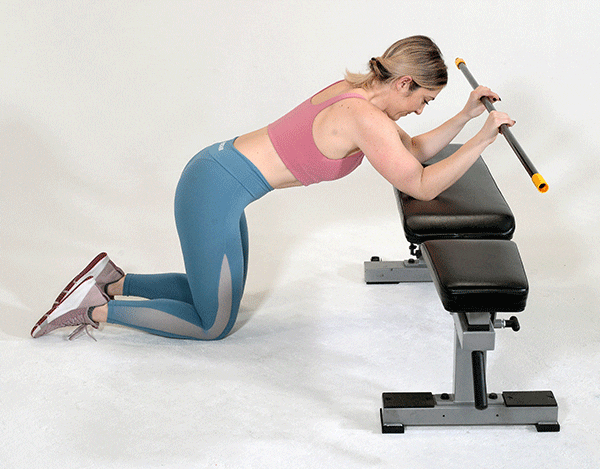
[ad_1]
It’s arm day on the gymnasium, however your hands are nonetheless sore from the final time you labored out. Is that this soreness conventional? Or is it an damage?
Learn on to be informed why your hands get sore, when you’ll be able to paintings in the course of the ache, and when the harm is one thing extra.
Why Are My Palms Sore?
“Behind schedule onset of muscle soreness is the commonest soreness that exercisers enjoy,” says Joel French, Ph.D., adjunct professor at Concordia College.
Your muscle tissue really feel sore when a muscle is challenged in a brand new method, like beginning a new activity program or lifting extra weight. The tension of that novel problem damages muscle tissue at the cell stage, inflicting “micro tears.” It’s totally standard, and a essential a part of the restore, expansion, and adaptation processes.
But when there’s over the top injury, the ensuing irritation and swelling may cause soreness, which most often peaks inside 48 hours and will final for a couple of days — therefore its identify: behind schedule onset muscle soreness (DOMS).
How Do I Relieve Sore Arm Muscle tissue?
Low-intensity activity and therapeutic massage can each lend a hand relieve exercise-induced muscle soreness. For the latter, you’ll merely paintings the sore muscle with an overly mild load. In case your triceps are sore, for instance, you could do the triceps extension with 15 kilos as an alternative of 25.
Therapeutic massage can also be as simple because the shoulder and chest stretch (described beneath), which makes use of a tennis ball to penetrate deep into muscle tissue. Certainly, stretching generally is some other efficient exercise-induced soreness reliever.
Higher Frame and Arm Stretches
Carry out the next stretches to ease rigidity, cut back soreness, and building up mobility and vary of movement on your hands, shoulders, and chest.
1. In the back of the pinnacle tricep stretch

We adore this stretch. It calls for no props, and you have got the approach to carry out this stretch whilst seated or status.
- Take a seat tall in a cross-legged place or stand tall along with your toes hip-width aside.
- Raise your proper arm towards the ceiling. Bend your proper elbow and achieve your palm again between your shoulder blades.
- Seize your elbow along with your left hand and gently pull your proper elbow to the left. You must really feel a stretch happening your tricep and towards your proper aspect.
- Cling for a couple of breaths and repeat to your different aspect.
2. Overhead bench stretch

- Seize a broomstick or in a similar fashion sized pole along with your fingers about six inches aside, arms down.
- Kneel in entrance of a bench or chair and position your elbows on its floor. Transfer your knees backward and decrease your torso towards the ground till you are feeling a deep stretch on your shoulders and lats.
- Cling for so long as you’ll be able to — as much as two mins.
3. Shoulder and chest stretch with a tennis ball

- Stand along with your proper aspect touching a wall, after which achieve your proper arm at the back of you, urgent your palm and arm in opposition to the wall.
- Your function is to get your proper arm parallel to the ground. In case your shoulders and higher frame are tight, this may imply that the entrance of your frame is orientated extra towards the wall as an alternative of perpendicular to it.
- Position a tennis ball or therapeutic massage ball between the criminal of your armpit and the wall, and transfer your frame to roll the ball round your chest and shoulder house.
- Repeat to your different aspect.
A Pulled Muscle or One thing Extra?
The adaptation between a sore muscle and an injured muscle isn’t at all times that obtrusive. However generally, exercise-induced soreness is simply that — soreness. It’s extra of a decent, achy feeling quite than an acute, localized, sharp ache.
“If the ache is minimum and most likely DOMS, steer clear of intense activity for a couple of days till it subsides,” says French. “If the ache is serious, get tested by way of a doctor ASAP to rule out a extra critical damage [such as a sprain or strain].”
A sprain is a ligament damage, through which the fibrous connective tissues used to glue bone to bone turns into overstretched or torn. Signs of a sprain contains joint or muscle ache, irritation, hindered motion, tenderness, and bruising.
A pressure is a muscle or tendon damage, which come with fibers that attach your muscle tissue to bone. Lines can occur from repetitive use or a unmarried incident. Signs come with muscle spasms, weak spot, cramping, ache, and bruising.
In the event you enjoy any of the ones or the next signs, make an appointment along with your physician.
- Critical ache and swelling within the arm.
- Arm ache that comes on all at once this is paired with drive or a “squeezing feeling” within the chest.
- Bother transferring the arm usually or turning the palm up or down.
[ad_2]